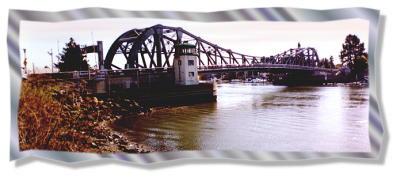High Street Bridge

The High Street Bridge is a two lane double leaf bascule bridge, similar to the bridge at Park Street, which spans the Oakland Estuary for 296 feet. The Oakland Estuary is a navigable water way with access to the San Francisco Bay. The phone at the bridge tower is (510) 533-1126.
A bascule bridge is a a draw bridge that is counterweighted so that it may be raised or lowered easily. Approximately 30,000 vehicles cross the bridge each work day.
HISTORY
The original iron swing bridge was completed in 1894 by the Harrison Bridge Company for $24,747. This bridge, and the Park Street and Fruitvale Avenue bridges, were built by the U.S. Government in exchange for permission and rights-of-way to dredge the channel between San Antonio Creek and San Leandro Bay. In May 1901 a fire destroyed the swing span and part of the approaches, which were rebuilt the following year. The present bridge was designed by the County of Alameda Surveyors Office and constructed under the Federal WPA Program in 1939 at a cost of $750,000.
OPENING
The High Street Bridge shall open on signal; except that, from 8:00 a.m. to 9:00 a.m. and 4:30 p.m. to 6:30 p.m. Monday through Friday except Federal Holidays, the draws need not be open for the passage of vessels. However, the draws shall open for the above closed periods for vessels which must, for reasons of safety, move on a tide or slack water, if at least two hours notice is given. The draws shall open as soon as possible for commercial vessels engaged in rescue or emergency salvage operations.
The bridge is manned by an alternating four person crew. The bridge is equipped with a Marine Radio, the preferred working channel in the San Francisco Bay Area is Channel 9 and Channel 16 is used for hailing and distress. Vessels can also gain a bridge opening by using a horn. The signal is a long blast followed by a short blast. Signal flags and lights may also be used if Coast Guard approved methods are followed. For more information on drawbridge operations, see "California Drawbridge Regulations" by the Coast Guard. Although draw bridges are required to open for vessel traffic even if that means that vehicular traffic must wait, there are some exceptions to this rule.
Vessel and Vehicle Traffic
- 1,400 Openings per year
- 1,700 Total Vessels
- 615 Barges
- Northbound 12,400 vehicles per day
- Southbound 13,588 vehicles per day
- Total Vehicle Traffic per day 26,000
- Busiest Hour North Bound 8 am to 9 am 1121 vehicles
- Busiest Hour South Bound 5 p.m. to 6 p.m. 1083 vehicles
- Slowest Hour North Bound 4 am to 5 am 34 vehicles
- Slowest Hour South Bound 4 am to 5 am 19 vehicles
WORKINGS OF THE BRIDGE
The High Street Bridge is a double leaf bascule bridge. Under normal operating conditions both leafs are used. Each leaf of the bridge can be operated independently. This gives the operator flexibility and helps keep the channel open for vessels in case one leaf is down for repairs.
Main power to the bridge is supplied by the Bureau of Electricity (City of Alameda) this provides the power to run both or one leaf of the bridge under full power using the 75 hp main motors located in each machinery room. Emergency power is supplied by Pacific Gas and Electric (PG&E). Emergency power can operate both or one leaf of the bridge only using the emergency drive system utilizing a 5 hp motor. There are two operator towers, the main operational tower is on the Oakland side of the bridge. The secondary tower in Alameda is a backup, and can only operate the Alameda side of the bridge. Four traffic gates and two cable barriers secure the bridge for vessel openings.
The Bridge has two machinery rooms one for each leaf. Each leaf is powered by a 75 hp main motor and 5 hp backup motor. Each leaf is stopped by a service brake and emergency braking is supplied by a hydraulic brake system. Thousands of pounds of steel are lifted by 5 HP, then almost perfect counterbalancing. A huge counterweight supplies the balancing needed for the 100 plus foot long section of bridge. The Counterweight Pit is 40 feet below the roadway and when you stand on the pit floor it is only concrete that separates you from the water.
Each leaf of the bridge can open to a 76 degree position, this is considered a full opening. A normal opening is 45 degrees and can accommodate 95% of vessel traffic. With a full opening the bridge can accommodate almost any vessel. The main limiting factor would be vessel width and the depth of the channel. The bridge can operate safely under wind conditions reaching 30 mph. Over 30 mph wind conditions caution must be used when operating the bridge.
RECENT IMPROVEMENT PROJECTS
A modernization project in 1981 updated many of the electrical and mechanical systems of the bridge. New control consoles, leaf drive systems, power distribution, underwater cables, air buffers, roadway and approach lighting, and much more was completed under the modernization. According to many operators, it was a vast improvement over the original equipment. This equipment is in use today and High Street Bridge is a very reliable Draw Bridge.
In 1996 another modernization project was competed. The High Street Bridge was completely stripped of all primer and paint. This was a difficult project as it was necessary to contain the lead based paint and primer from entering the waterway and the San Francisco Bay. The bridge was completely enclosed in a tent like structure and all paint material was sucked up by huge vacuum's. While High Street Bridge had many touch up paint jobs over the years this was the first complete paint job in over 50 years.
Over 25,000 pounds of paint was removed from the bridge during the project. This changed the operation of the bridge and adjustments had to be made to the counterbalancing to make the bridge operate correctly. In addition to the paint job, new energy efficient roadway and approach way lights were installed and closed circuit monitors and cameras were installed to aid the in the operation of the bridge.
BRIDGE STATISTICS
- Vertical Clearance MLLW (Low Tide) 21 Feet
- Vertical Clearance MHHW (High Tide) 14 Feet 6 inches
- Clearance Between Fenders 200 Feet
- Bridge Height Restriction for Vehicles 15 Feet 6 inches
- Bridge Width 37 Feet
- Bridge Length 250 Feet
- Width of Roadway 24 feet
- Pedestrian Sidewalk 6 Feet

